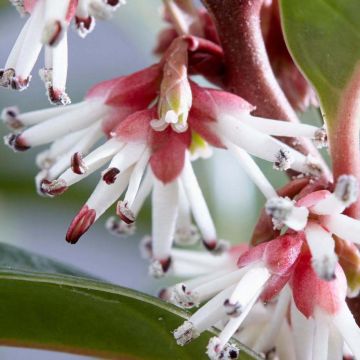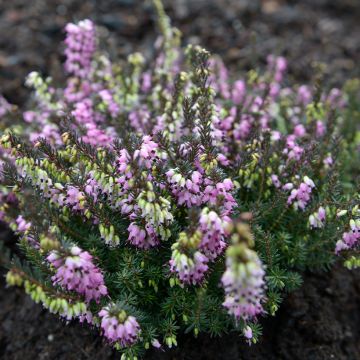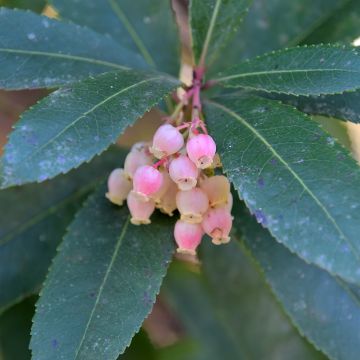

Ptelea trifoliata Aurea - Orme de Samarie doré
Ptelea trifoliata Aurea - Hoptree
Ptelea trifoliata Aurea
Golden Hoptree, Golden Wafer Ash, Golden Stinking Ash, Golden Skunk bush
The "bud removers" have finally been unmasked. Due to the almost daily storms, it is actually an army of voracious gastropods that systematically devour all the new leaves. I have to plant repellent plants at the base of the Ptelea (if such things really exist) in order to avoid damaging the declining winged fauna this year. A real puzzle. To be continued.
Nathalie , 21/06/2023
Special offer!
Receive a €20 voucher for any order over €90 (excluding delivery costs, credit notes, and plastic-free options)!
1- Add your favorite plants to your cart.
2- Once you have reached €90, confirm your order (you can even choose the delivery date!).
3- As soon as your order is shipped, you will receive an email containing your voucher code, valid for 3 months (90 days).
Your voucher is unique and can only be used once, for any order with a minimum value of €20, excluding delivery costs.
Can be combined with other current offers, non-divisible and non-refundable.
Home or relay delivery (depending on size and destination)
Schedule delivery date,
and select date in basket
This plant carries a 24 months recovery warranty
More information
We guarantee the quality of our plants for a full growing cycle, and will replace at our expense any plant that fails to recover under normal climatic and planting conditions.
Would this plant suit my garden?
Set up your Plantfit profile →
Description
Ptelea trifoliata, also known as Samaritan Elm, is a little-known North American species that is not widely planted in European gardens, despite its remarkable adaptability. This shrub or small tree is not an elm, but belongs to the same family as citrus trees, which explains why its foliage is also fragrant. Its golden colour in spring and autumn further enhances its appeal. Its discreet spring flowering is both fragrant and melliferous, giving way to decorative clusters of winged fruits that last until late in the season. Its trifoliate leaves give it an exotic look, especially since its rarity makes it difficult to identify. Hardy and very accommodating, it deserves to be more widely planted in our gardens.
Ptelea trifoliata is a member of the Rutaceae family, which includes about 160 genera, including the large group of citrus trees and related species, as well as numerous ornamental genera such as Choysia (Mexican Orange), Skimmia, and Boronia. Ptelea is monospecific and is native to a vast area covering eastern North America, from Mexico to the United States and Quebec. In the wild, it is often found anchored in rocky hillsides in mountainous areas, on shallow soils where it develops thick roots. The Hop Tree often develops several thin and twisted trunks, showing an overall open habit and a sparse and wide crown supported by upright and intertwined branches. It is a large shrub or small tree that is very hardy, with slow growth, reaching about 6 m (20ft) in height and 4 m (13ft) in width.
The cultivar 'Aurea' is a horticultural introduction that enhances the ornamental interest of this species. Even rarer than the type, it offers particularly decorative foliage in spring when the three-leaved compound leaves emerge with a beautiful yellow colour. They then turn lime green during the season before becoming golden again in autumn for a grand finale. The bark covering the trunk and branches is initially smooth and reddish-brown, but becomes more grayish and slightly grooved with time. The branches bear a very dense, deciduous foliage that falls late in autumn and develops late in spring. When crushed, it releases a musky and lemon scent, aromatic compounds that betray its membership to the Rutaceae family. The leaves, which are somewhat soft in texture and measure 6 to 15 cm (2 to 6in) in length, are divided into 3 ovate lobes with pointed tips.
Ptelea trifoliata 'Aurea' has a discreet flowering period in June, with clusters of small white-cream star-shaped flowers, 1 to 2 cm (1in) wide, appearing among the leaves. Intensely nectar-rich, they emit a heady fragrance reminiscent of honeysuckle, more noticeable at dusk, and more or less appreciated by humans, but attracting bees and butterflies. The flowers are followed in late summer by generous clusters of small nuts, each surrounded by a green, then yellow-brown oval membrane, measuring 2 to 2.5 cm (1in) in diameter and having a papyraceous texture. Dispersed by the wind, they are appreciated by many birds and small mammals. These fruits, also aromatic, can be used as a substitute for hops in beer production.
Very accommodating, this slow-growing small tree adapts to most soils, except for excessively acidic ones. It appreciates humus but can grow in poor soil, from moderately moist to moderately dry, and can tolerate drought once well-rooted. It also tolerates wind quite well. Hardy to about -20 °C (1°F), its adaptability and moderate size make it suitable for almost any garden. It can tolerate full sun, which is not always the case for golden-leaved plants that tend to scorch in this type of exposure, but it also grows well in partial shade.
If the green Hop Tree is suitable for wild, natural gardens, this golden variety is worthy of being included among other horticultural selections. You can create strong colour contrasts by planting purple foliage next to it, a classic but always effective combination. Choose the very attractive Cercis canadensis Forest Pansy, a small tree with heart-shaped leaves that are highly decorative. If you prefer lighter foliage, opt for the Albizia 'Summer Chocolate', where it's hard to decide what to admire most, between its fern-like cut leaves with an incredible almost black colour or its large feathery flowers. If you plant your 'Aurea' Hop Tree in the background, many smaller-sized shrubs also offer interesting purple foliage, such as the upright Sambucus nigra Black Tower, or for more compact forms, one of the many purple-leaved Physocarpus, such as 'All Black', aptly named, or the tiny Cotinus coggygria Lilla, a miniature version of the Smokebush.
Report an error about the product description
Ptelea trifoliata Aurea - Hoptree in pictures


Plant habit
Flowering
Foliage
Botanical data
Ptelea
trifoliata
Aurea
Rutaceae
Golden Hoptree, Golden Wafer Ash, Golden Stinking Ash, Golden Skunk bush
Cultivar or hybrid
Other Shrubs A to Z
View all →Planting and care
Ptelea trifoliata 'Aurea' is best planted in autumn in a soil preferably rich in humus and well-drained. It appreciates rocky, sandy, loamy or clay-loamy soils that do not retain excess water: its roots can rot in flooded or too compact soil. While it develops faster in slightly moist soil, it adapts perfectly to rocky, shallow and drier soils in summer, once well established. Plant it in a sunny, partially shaded, or even shaded position, especially in hot regions. It adapts to all climates but does not like excessively acidic or excessively calcareous soils (pH between 6 and 7.8). Water and mulch during the first summers. The Hop Tree may be susceptible to foliar spots and rust, without harmful consequences.
Planting period
Intended location
Care
-
, onOrder confirmed
Reply from on Promesse de fleurs
Similar products
Haven't found what you were looking for?
Hardiness is the lowest winter temperature a plant can endure without suffering serious damage or even dying. However, hardiness is affected by location (a sheltered area, such as a patio), protection (winter cover) and soil type (hardiness is improved by well-drained soil).

Photo Sharing Terms & Conditions
In order to encourage gardeners to interact and share their experiences, Promesse de fleurs offers various media enabling content to be uploaded onto its Site - in particular via the ‘Photo sharing’ module.
The User agrees to refrain from:
- Posting any content that is illegal, prejudicial, insulting, racist, inciteful to hatred, revisionist, contrary to public decency, that infringes on privacy or on the privacy rights of third parties, in particular the publicity rights of persons and goods, intellectual property rights, or the right to privacy.
- Submitting content on behalf of a third party;
- Impersonate the identity of a third party and/or publish any personal information about a third party;
In general, the User undertakes to refrain from any unethical behaviour.
All Content (in particular text, comments, files, images, photos, videos, creative works, etc.), which may be subject to property or intellectual property rights, image or other private rights, shall remain the property of the User, subject to the limited rights granted by the terms of the licence granted by Promesse de fleurs as stated below. Users are at liberty to publish or not to publish such Content on the Site, notably via the ‘Photo Sharing’ facility, and accept that this Content shall be made public and freely accessible, notably on the Internet.
Users further acknowledge, undertake to have ,and guarantee that they hold all necessary rights and permissions to publish such material on the Site, in particular with regard to the legislation in force pertaining to any privacy, property, intellectual property, image, or contractual rights, or rights of any other nature. By publishing such Content on the Site, Users acknowledge accepting full liability as publishers of the Content within the meaning of the law, and grant Promesse de fleurs, free of charge, an inclusive, worldwide licence for the said Content for the entire duration of its publication, including all reproduction, representation, up/downloading, displaying, performing, transmission, and storage rights.
Users also grant permission for their name to be linked to the Content and accept that this link may not always be made available.
By engaging in posting material, Users consent to their Content becoming automatically accessible on the Internet, in particular on other sites and/or blogs and/or web pages of the Promesse de fleurs site, including in particular social pages and the Promesse de fleurs catalogue.
Users may secure the removal of entrusted content free of charge by issuing a simple request via our contact form.
The flowering period indicated on our website applies to countries and regions located in USDA zone 8 (France, the United Kingdom, Ireland, the Netherlands, etc.)
It will vary according to where you live:
- In zones 9 to 10 (Italy, Spain, Greece, etc.), flowering will occur about 2 to 4 weeks earlier.
- In zones 6 to 7 (Germany, Poland, Slovenia, and lower mountainous regions), flowering will be delayed by 2 to 3 weeks.
- In zone 5 (Central Europe, Scandinavia), blooming will be delayed by 3 to 5 weeks.
In temperate climates, pruning of spring-flowering shrubs (forsythia, spireas, etc.) should be done just after flowering.
Pruning of summer-flowering shrubs (Indian Lilac, Perovskia, etc.) can be done in winter or spring.
In cold regions as well as with frost-sensitive plants, avoid pruning too early when severe frosts may still occur.
The planting period indicated on our website applies to countries and regions located in USDA zone 8 (France, United Kingdom, Ireland, Netherlands).
It will vary according to where you live:
- In Mediterranean zones (Marseille, Madrid, Milan, etc.), autumn and winter are the best planting periods.
- In continental zones (Strasbourg, Munich, Vienna, etc.), delay planting by 2 to 3 weeks in spring and bring it forward by 2 to 4 weeks in autumn.
- In mountainous regions (the Alps, Pyrenees, Carpathians, etc.), it is best to plant in late spring (May-June) or late summer (August-September).
The harvesting period indicated on our website applies to countries and regions in USDA zone 8 (France, England, Ireland, the Netherlands).
In colder areas (Scandinavia, Poland, Austria...) fruit and vegetable harvests are likely to be delayed by 3-4 weeks.
In warmer areas (Italy, Spain, Greece, etc.), harvesting will probably take place earlier, depending on weather conditions.
The sowing periods indicated on our website apply to countries and regions within USDA Zone 8 (France, UK, Ireland, Netherlands).
In colder areas (Scandinavia, Poland, Austria...), delay any outdoor sowing by 3-4 weeks, or sow under glass.
In warmer climes (Italy, Spain, Greece, etc.), bring outdoor sowing forward by a few weeks.


















































